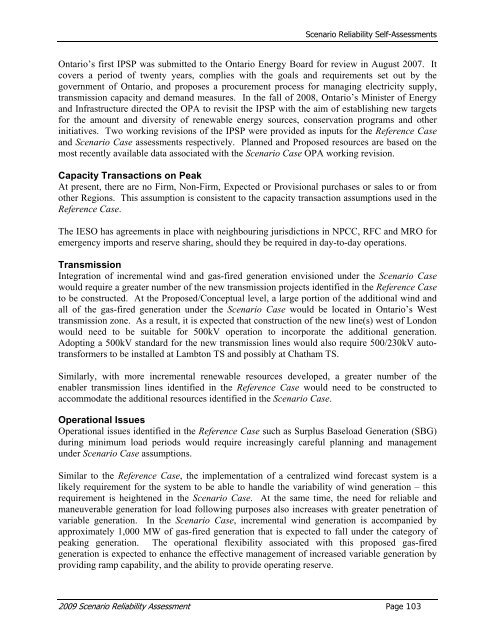2009 Scenario Reliability Assessment - NERC
2009 Scenario Reliability Assessment - NERC
2009 Scenario Reliability Assessment - NERC
- No tags were found...
Create successful ePaper yourself
Turn your PDF publications into a flip-book with our unique Google optimized e-Paper software.
<strong>Scenario</strong> <strong>Reliability</strong> Self-<strong>Assessment</strong>sOntario’s first IPSP was submitted to the Ontario Energy Board for review in August 2007. Itcovers a period of twenty years, complies with the goals and requirements set out by thegovernment of Ontario, and proposes a procurement process for managing electricity supply,transmission capacity and demand measures. In the fall of 2008, Ontario’s Minister of Energyand Infrastructure directed the OPA to revisit the IPSP with the aim of establishing new targetsfor the amount and diversity of renewable energy sources, conservation programs and otherinitiatives. Two working revisions of the IPSP were provided as inputs for the Reference Caseand <strong>Scenario</strong> Case assessments respectively. Planned and Proposed resources are based on themost recently available data associated with the <strong>Scenario</strong> Case OPA working revision.Capacity Transactions on PeakAt present, there are no Firm, Non-Firm, Expected or Provisional purchases or sales to or fromother Regions. This assumption is consistent to the capacity transaction assumptions used in theReference Case.The IESO has agreements in place with neighbouring jurisdictions in NPCC, RFC and MRO foremergency imports and reserve sharing, should they be required in day-to-day operations.TransmissionIntegration of incremental wind and gas-fired generation envisioned under the <strong>Scenario</strong> Casewould require a greater number of the new transmission projects identified in the Reference Caseto be constructed. At the Proposed/Conceptual level, a large portion of the additional wind andall of the gas-fired generation under the <strong>Scenario</strong> Case would be located in Ontario’s Westtransmission zone. As a result, it is expected that construction of the new line(s) west of Londonwould need to be suitable for 500kV operation to incorporate the additional generation.Adopting a 500kV standard for the new transmission lines would also require 500/230kV autotransformersto be installed at Lambton TS and possibly at Chatham TS.Similarly, with more incremental renewable resources developed, a greater number of theenabler transmission lines identified in the Reference Case would need to be constructed toaccommodate the additional resources identified in the <strong>Scenario</strong> Case.Operational IssuesOperational issues identified in the Reference Case such as Surplus Baseload Generation (SBG)during minimum load periods would require increasingly careful planning and managementunder <strong>Scenario</strong> Case assumptions.Similar to the Reference Case, the implementation of a centralized wind forecast system is alikely requirement for the system to be able to handle the variability of wind generation – thisrequirement is heightened in the <strong>Scenario</strong> Case. At the same time, the need for reliable andmaneuverable generation for load following purposes also increases with greater penetration ofvariable generation. In the <strong>Scenario</strong> Case, incremental wind generation is accompanied byapproximately 1,000 MW of gas-fired generation that is expected to fall under the category ofpeaking generation. The operational flexibility associated with this proposed gas-firedgeneration is expected to enhance the effective management of increased variable generation byproviding ramp capability, and the ability to provide operating reserve.<strong>2009</strong> <strong>Scenario</strong> <strong>Reliability</strong> <strong>Assessment</strong> Page 103
















